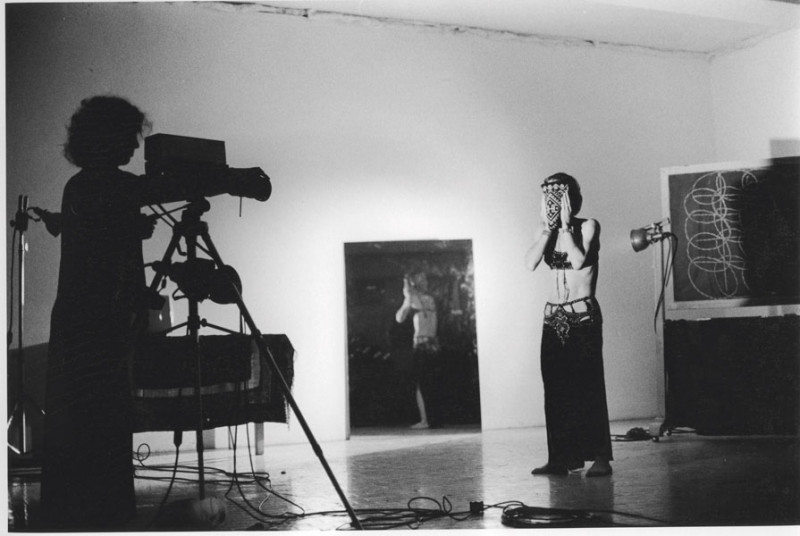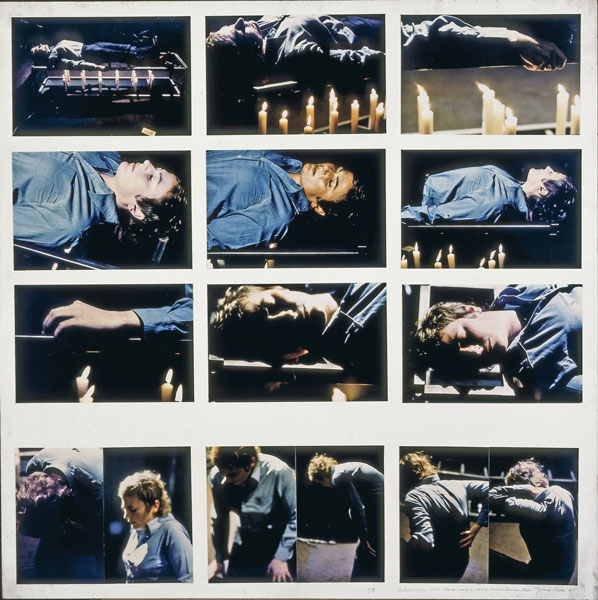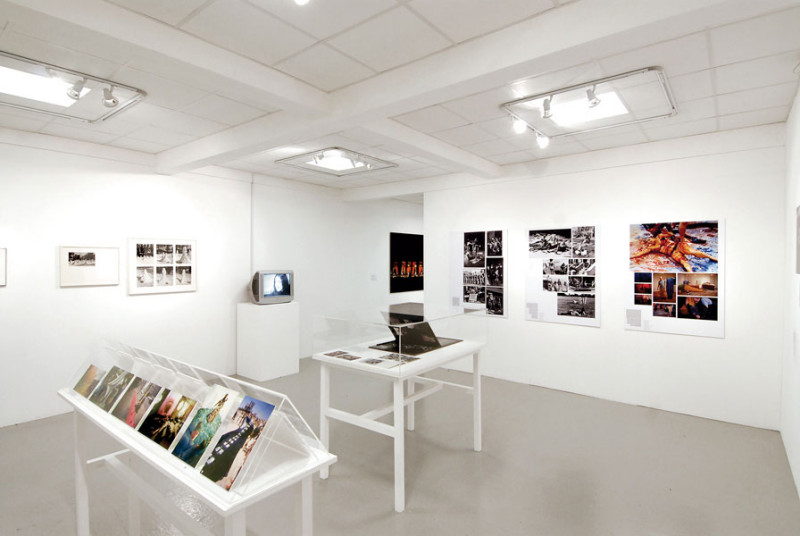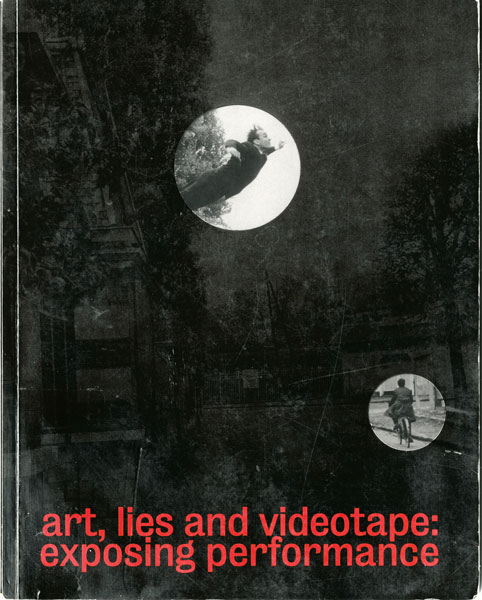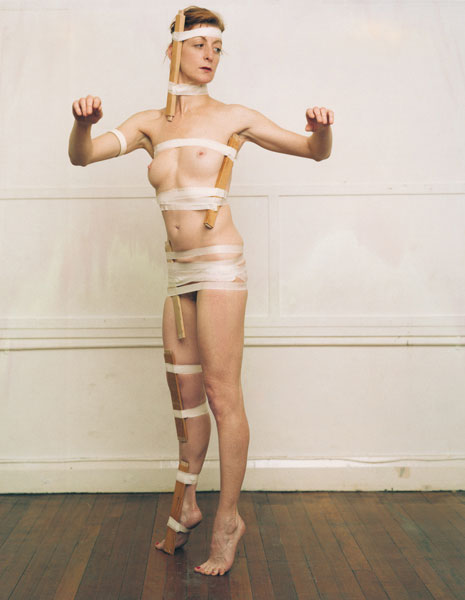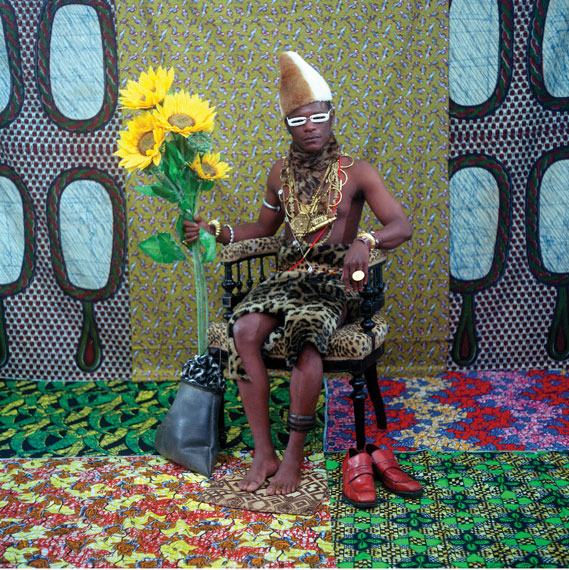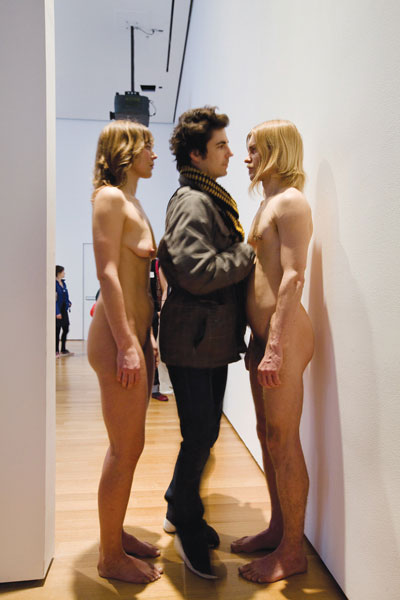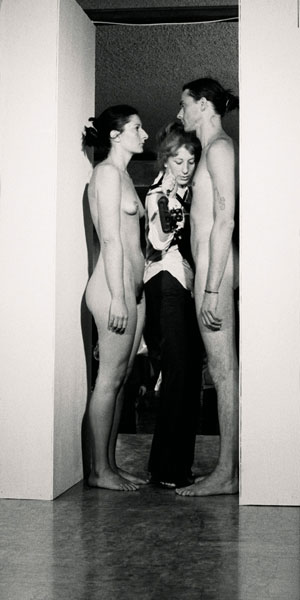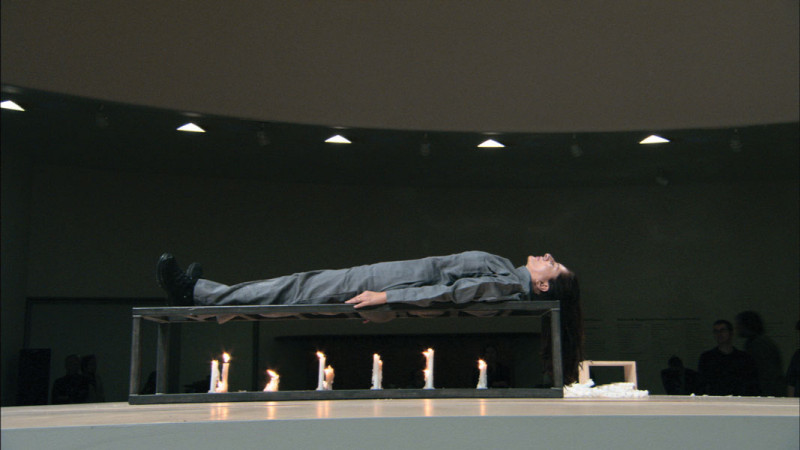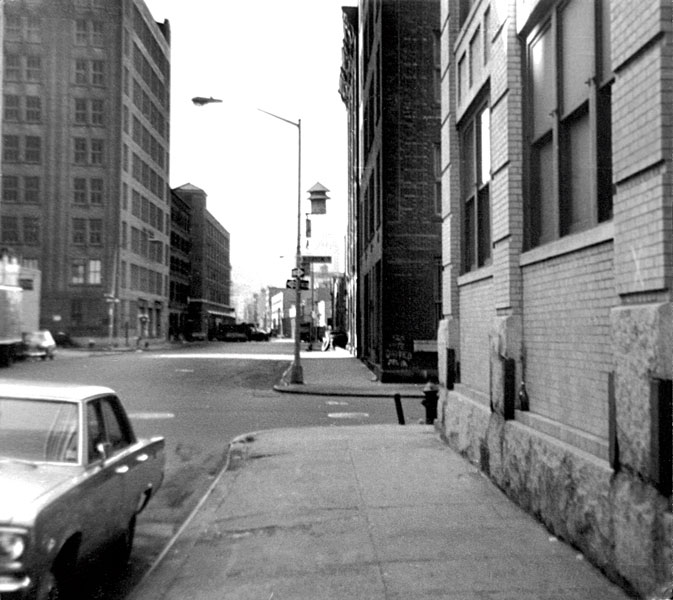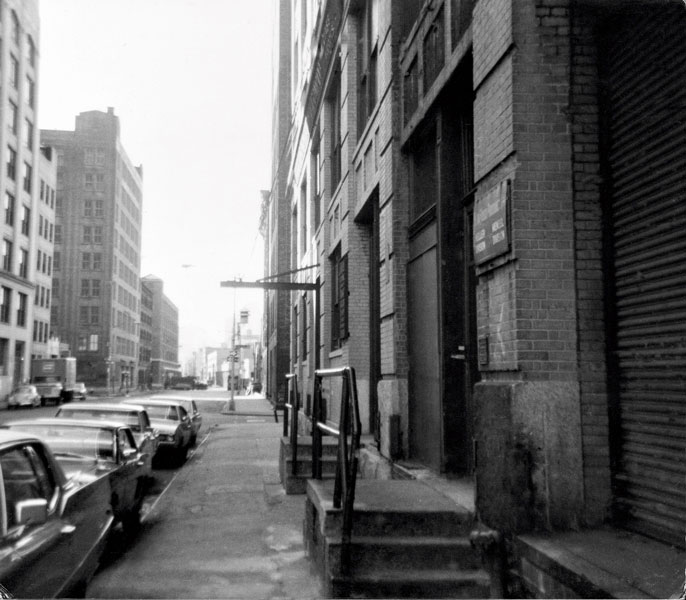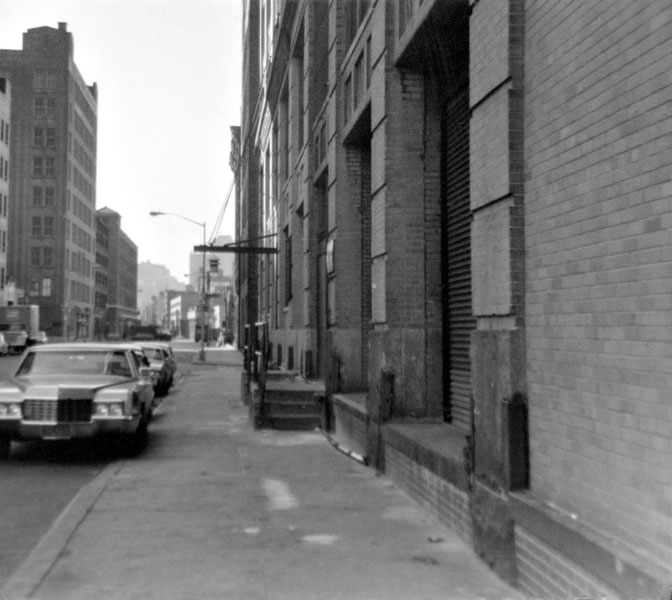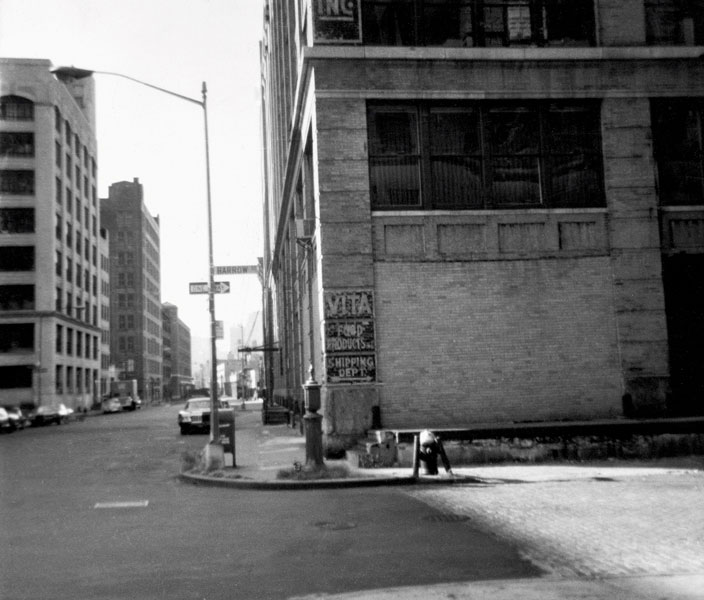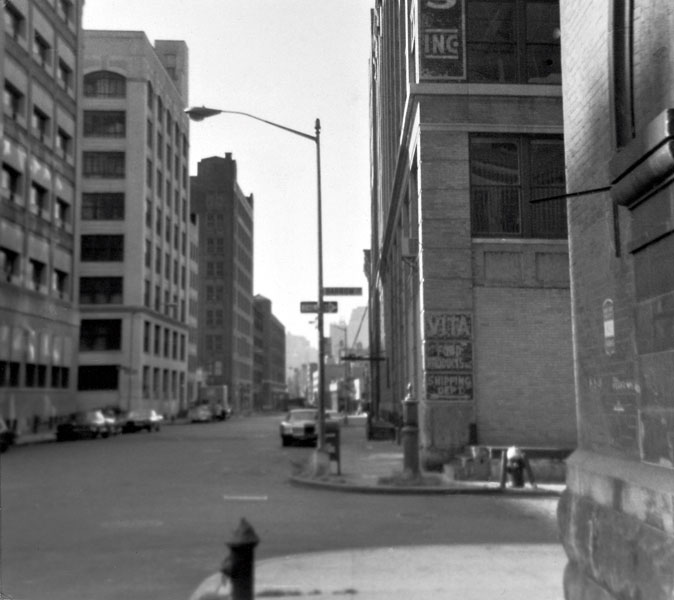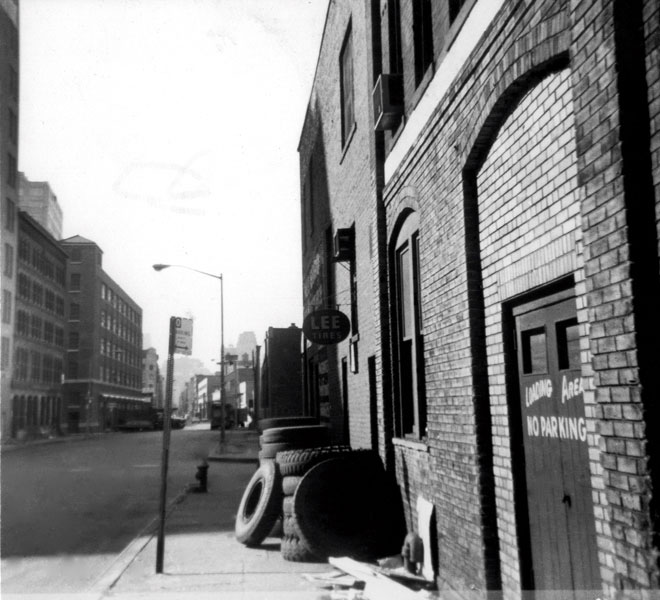[Fall 2010]
by Anne Bénichou
The status of performance images oscillated among documentation, stand-alone artwork, and notation with an eye to eventual re-creations. These three conceptions flow from theoretical, aesthetic, and political approaches that are quite divergent and not completely synchronous in the history and theorization of performance. The first is related to the authenticity of the performative work (a unique event, not reproducible or reiterable). The live event is overvalued to the detriment of the images made of it, to which only an ancillary function is accorded. The second emerges from a questioning of the value of authenticity and an interest in the means of recording and mediatizing the performance. Recordings and documentation are valued to the detriment of the live event. This reassessment establishes an emphasis on the aesthetic value of images over their documentary and indicial value. The third is also defined through a rejection of the value of authenticity. The image is seen as a script that allows the performative work that it portrays to be re-created. Such a meaning presumes, on the theoretical level, that an image is simultaneously the trace and the virtualization of an event. In this essay, I analyze these three positions, which correspond, respectively, to three periods in the history of performance theory: approximately, the 1960s and 1970s, the 1980s and 1990s, and the 2000s, although there is some overlap among both the periods and the conceptions.
Presence and Authenticity, or Depreciation of the Document
During the 1960s and 1970s, a number of artists and theoreticians envisaged performance as an art of presence, of the here and now. Performer and public met in a real and singular space and time, giving rise to a unique phenomenon: the performance. The performance was thus limited to when and where it took place. This emphasis on the here and now made the performance auratic, in the Benjaminian sense of the term, and was accompanied by an idealization, even sacralization, of the artist’s body, which was perceived as an incarnating body, a sanctuary of authenticity. At a time when the modern myths of the artist inherited from romanticism were being challenged, performance seemed to constitute one of their last bastions, an ultimate art form capable of guaranteeing the artist’s presence and communion with the viewer. This valorization of direct experience owed a debt to the heritage of Antonin Artaud, whose The Theatre and Its Double, advocating a theatre of life, authenticity, and improvisation, had a considerable influence on the teaching at Black Mountain College and on many post-war American artists who taught or studied there.5
This idea of performance, quite dominant until the late 1970s, engendered a depreciation of the resulting images and our experience of them. Photographs, films, and videos of performances could not reconstitute the phenomenal and singular experience of the event. They were reduced to an ancillary function and, until very recently, provoked little interest. As Rebecca Schneider has shown, perfor-mance theoreticians created a separation and hierarchy of the live (the performance) and the archival (documentation).6 Authors such as Ira Licht, Rosemary Mayer, Cindy Nemser, and, more recently, Catherine Elwes follow this line of thought.7
The devaluing of performance images is also linked to their very poor aesthetic quality, their limited distribution, and the attachment of their makers to the testimonial value of the document. Perfor-mance photographs made in the 1960s and 1970s are almost all in black and white, and some are difficult to “read” due to the poor conditions under which they were taken. The almost-exclusive use of black-and-white photography was more a constraint than a choice. Colour film was much too expensive; its low sensitivity would have made it difficult to use in the picture-taking conditions that the performance required (low light and subjects in motion).
These images saw relatively limited circulation. They were published mainly in counter-culture magazines created in the 1970s and used to document and disseminate experimental art practices that were developing outside of official art institutions: ArTitudes in France, Avalanche in the United States, File in Canada, Gutai in Japan, Interfunktionen in Germany, and so on. Although these magazines had different editorial orientations, they devoted much (sometimes exclusive) space to artists’ words through interviews and essays that accompanied the visual documents. Their editors favoured photographic layouts that conveyed the temporal nature of the works. They privileged series and sequences; they played with a certain congruence among the temporalities of performances, their recording, and the reading of the magazine, which was scanned by flipping through the pages. When these magazines folded, no other means of dissemination took up the torch. Images accumulated in the archives, many of them colossal and unfortunately little exploited, that photographers and artists kept in their homes or studios.
Aside from their poor visual quality and lack of visibility, these images fell within a conception of photography, based on the testimonial value of the photographic medium, that was put into question (not to mention seen as suspect) in the 1980s. For instance, Babette Mangolte, who was among the important photographers in the New York alternative art scene of the 1970s, explained in her professional autobiography published in October that the images that she made were based on a certain type of relationship between photography and reality, on a quest for “photographic truth.”8 The photojournalist Peter Moore, who documented happenings in New York in the late 1950s and during the following decade, also claimed “photographic truth”:
“I believe in photography as a truth telling thing … . I would suffer the loss of a good photograph rather than falsify the [piece’s] premise”.9
This belief in the capacity of photography to report on the reality of an event was counteracted by the medium’s obvious limitation with regard to performance: its incapacity to testify to the temporality of works. In their quest to produce evidence and traces of these actions, photographers and artists developed working methods and visual languages that enabled them to convey in fixed images the aesthetic conceptions proper to each performance. Over the time that she attended performances, Mangolte developed a true photographic ethic. Photography enabled her to assert her gaze and analytic abilities, while measuring them against other subjectivities. Each encounter enabled her to refine her approach and adapt it to different practices.10 Chris Burden created a unique documentation system. Working with non-professional photographers, he selected a single image per perfor-mance, deliberately reducing the duration of the work to a single instant, and accompanied it with a descriptive legend whose laconic tone contrasted with the violence of the actions. “The photograph,” he explained, “is important because it becomes a symbol for the whole event and also an image in itself. I think a lot of my performance can be represented by a single image, and for performance that is unusual.”11 Gina Pane, on the contrary, collaborated with a professional photographer, Françoise Masson, who was the only one authorized to be near her during performances. The pictures that she wanted were meticulously prepared before the action.12 Masson took a great number of shots, which were then sorted according to the use that they would be put to. Some were sent to the media and therefore had no artistic stat-us. Others, chosen for their emblematic, expressive, or emotional qualities, were used to establish constats photographiques (photographic reports), large montages of image sequences that the artist considered to be original works.
These methods and conceptions, specific to each photographer and artist, have not yet received enough attention; considerable research and analysis remain to be accomplished. Mangolte has repeatedly deplored the lack of interest that art historians and publishers bringing out books about performance have shown in photographic archives. They continue to publish the same images, to her chagrin, and do not take the time to look at contact sheets that are bursting with information. Things are beginning to change, and a number of voices have recently been raised to advocate for the rehabilitation of these images, so remote from current aesthetics and photographic approaches, by both art historians and art institutions. During the roundtable that she organized in 2007, You Didn’t Have to Be There, RoseLee Goldberg emphasized the importance of developing the skill of reading performance images because they contain large amounts of information on the works, on how artists conceived their transmission, and on the contexts for their creation and dissemination; furthermore, they had a considerable influence on photographic practices of the 1980s and on visual culture as a whole.13 For fifteen years, Alice Maude Roxby conducted interviews with the main photographers who documented performances in Japan, Europe, and the United States, in order to understand their working methods, the terms of the collaboration that they established with artists, and the articulation of performance photography with their other fields of photographic activity. This research gave rise to the 2007 exhibition “Live Art on Camera: Performance and Photography” at the gallery at the University of Southampton, and to a reflection on how perfor-mance images are exhibited in museums, as their shift from archive to gallery wall was not a foregone conclusion since most of them were conceived in resistance to art institutions and the art market.14
A Second Depreciation: When the Document Becomes an Artwork
The 1980s marked a change of direction on both the theoretical and aesthetic fronts. The intellectual climate, dominated by postmodern thinkers who advocated deconstruction and a critique of representation, led to a re-evaluation of the notions of presence and the immediacy of the experience attached to performance. Attention was now turned to the mechanisms for reproduction and recording of performative practices and the images that were made of them. On the aesthetic level, photographs of performances attained such visual quality that they were now considered works in their own right and gradually came to occupy the walls of museums and galleries alongside works from other art-photography practices.
In the early 1980s, the notions of presence and live experience that had dominated discourses on performance were challenged; theoreticians were more interested in modes of mediatization of performance. The colloquium organized in Montreal by the magazine Parachute, Performance et multidisciplinarité: postmodernisme, is exemplary of this evolution.15 Thierry de Duve, who wrote the first essay in the eponymous book, tried to redefine the concept of presence.16 Borrowing from Walter Benjamin the notions of “actuality” as a form of presence of reproducible works and of “exhibition value” as substitute for the “cult value” of authentic art forms, de Duve advanced the hypothesis of a presence that would presume “the mediation of a reproduction system.”17 He then began to be interested in recording systems and the representations that they generated. On the aesthetic level, his predilection was for works that integrated their own reproduction system.
This theoretical shift rehabilitated the status of performance images. Far from being relegated to an ancillary function, they were now a full extension of the performance. However, this tended to dislodge their documentary and testimonial value to a secondary position, and sometimes to negate it. On the semiological front, their indiciality was put challenged. Some tried to redefine it, while others went so far as to eliminate it. Amelia Jones and Philip Auslander offer good examples of these two respective positions. Both accord a fully artistic status to performance images, but their positions diverge with regard to how to think of their referentiality and indiciality.
In a now-famous article published in 1997 in Art Journal, ‘Presence’ in Absentia: Experiencing Performance as Documentation,” Jones rehabilitated the experience of the performance through its documentation, and she pleaded in favour of a history and analysis of performative works based on the interpretation of the documents that they have generated.18 Born in the early 1960s, Jones, like all art historians of her generation and the following ones, knew about body art works only through their documentation, a situation that she did not see at all as a handicap. Her arguments are the following. In line with postmodern thinkers, she reiterates the impossibility of having a direct, unmediatized relationship with an event. Furthermore, by taking the body as material, body art works play on the symbolic and may therefore claim a status of representation, with documentation making this aspect of the performance only more tangible. Finally, by participating in the questioning of modern myths of the artist, body art works proceed neither from the direct expression of an authentic individuality nor from the public’s communion with it. Rather, they create an intersubjective space in which interpretive exchanges between the artist and viewers are played out and negotiated. According to Jones, documentation fully brings to light these games of negotiation. On the one hand, the meanings of the body in action depend on the way in which the images that represent it are interpreted. On the other hand, the multiple “documentary supplements” through which we construct and reconstruct meaning according to infinite chains of interpretations tend to erase the original event. However, Jones does not refute the indiciality of the document. Following Rosalind Krauss’s thinking about the index, she suggests a reciprocal indicial relationship, a mutual supplementation: the performance needs photography to attest to its existence; the photograph needs the performance as anchor for its own indiciality. In the absence of the second term, the document may construct an entirely fictional space.
In “The Performativity of Performance Documentation,” an article published in 2006 in Performance Art Journal, Auslander abolished the distinction between two conceptions of performance documentation, one of a documentary nature (the document is proof, an attestation that the event that it represents really took place), the other theatrical (the performance was executed only to be photographed; it does not exist outside of the photographic image).19 Making a parallel with the status of recording in music, and specifically with phonography, to which he accords the full status of musical performance even if it exists only through the recording, Auslander proposes that the document takes the place of performance (it is performative in the linguistic sense of the term). Now, its link to the event that really took place is completely unimportant. Auslander sees as equivalent the photograph of the performance Shoot, during which Chris Burden had himself shot in the arm, and the famous photomontage by Yves Klein, Le saut dans le vide, which shows the artist jumping out of a building above a street, without protection. Auslander relegates to a secondary position the fact that the event shown in the former work really took place and the one in Klein’s photomontage never took place (Klein really did jump into the void, but above a safety net). “If we are concerned with the historical constitution of these events as performances, it makes no difference at all,” Auslander writes. And, he continues, this has “no consequence in terms of their iconicity and standing in the history of art and performance.”20 Even though the categories of theatre and documentary are becoming increasingly blurred, Auslander’s conclusion may seem debatable. If a person thought that Burden had not really been shot in the arm and that Klein had really jumped, that person would commit an error of interpretation regarding the respective approaches of the two artists. It is perhaps imprudent to eliminate the question of the referent so radically. Regarding the double indiciality that his colleague defends, Auslander writes, “While this formulation questions the performance’s status as the originary event by suggesting the mutual dependence of performance and document (the performance is originary only insofar as it is documented), it also reaffirms the status of the photograph as an access point to the reality of the performance.”21
Auslander’s position is explained in part by the aesthetic changes that performance photography underwent during the 1980s. At the beginning of the decade, the video-camera market was developing, and these devices became more accessible to artists as they dropped in price. The new medium was favoured for documenting performances because it was able to sow their temporality. Photography was not abandoned, but its uses changed. Artists were interested in it less for documentary and archivistic purposes than for promotional ones. They commissioned their photographers to make colour images of impeccable quality. Such photographs were not intended to appear in counter-culture magazines, which no longer existed; rather, they were destined for the more deluxe publications of the 1980s and 1990s, and sometimes for display on the walls of galleries and museums. The performance image entered the art market. A number of well-known photographers of preceding decades did not wish to conform to these new requirements and abandoned performance photography. This was the case for Mangolte, who turned to film.
Manuel Vason is exemplary of this evolution and the more assertive forms that it takes today. A fashion photographer, he has, since the early 2000s, been formulating projects in collaboration with fairly radical British performers emerging from the United Kingdom’s Live Art scene: Franko B., Ron Athey, Ernst Fischer, Helena Goldwater, La Ribot, Kira O’Reilly, and others. At first, Vason photographed live performances, but he quickly felt limited by the presence of the public and the restrictions imposed upon him. He therefore extended his photography sessions to periods before and after the public performances, and he finally stopped photographing live events entirely. In close collaboration with the performers, he determined the spaces, props, and poses for his pictures. The resulting excellent-quality very-large-format Polaroids constitute new works with an aesthetic that borrows from performance photography, fashion, portraiture, and advertising. As they are considered to be collaborations, these works have a shared copyright.
Changes in the aesthetic and uses of performance photography had the corollary of widespread use of mise en scène and performance in art practices. In the 1980s, many artists began to turn to the performative to make their images, including photographers who used “self-mise en scène” as a stage for their questioning of identity: Cindy Sherman, Suzy Lake, Shelley Niro, and, later, Yasumasa Morimura, Samuel Fosso, and others. Aesthetically, these artists’ images are not so different from those produced at performers’ request. There seems to be an affinity between the two practices: performance photographs have made mise en scène and “performed” images possible; conversely, the latter have had an impact on the aesthetic of the former. Should they therefore be seen as equivalent?
From the museological point of view, the trend is toward doing away with distinctions. The exhibition “Art, Lies and Videotape: Exposing Performance,” organized in 2003 at the Tate Liverpool, seems to have been an exception.22 Instead of melding the categories of document and artwork, index and simulacrum, true and false, this exhibition explores the shift from trace to icon, from evidence to fiction. Although the lines between these categories are thin, it seems all the more important to continue to think about and question them today because a new use of performance documents, developing in the context of re-enactments, is raising debate.
Re-enactment and the Image-Score
Since the turn of the millennium, re-enactment has emerged as a new mode of performance transmission, not because it is a new practice in the history of performance – many artists reperformed their pieces in the 1960s, even though non-repetition was the word of the day – but it seems to have entered the culture of museums and art history and, as a consequence, participates in the historicization of performance. In 2002, the Whitechapel Art Gallery reconstructed a number of historic performances, including Carolee Schneeman’s Meat Joy and Hermann Nitsch’s Orgies Mysteries Theater, for an exhibition titled “A Short History of Performance: Part One.”23 For the biennale Performa 05, in 2005, Marina Abramovic reinterpreted several historic performances at the Solomon R. Guggenheim Museum, the famous “7 Easy Pieces.”24 In 2006, the Haus der Kunst in Munich recreated a number of Allan Kaprow’s happenings during a retrospective devoted to the artist.25 Others were reconstructed the following year for Performa 07, including the celebrated “18 Happenings in Six Parts.”26 In 2008, for the Performance Exhibition Series, the Museum of Modern Art in New York reconstructed pieces by Yvonne Rainer and Simone Forti;27 on March 14, 2010, the same institution inaugurated a retrospective of perfor-mances by Marina Abramovic, “The Artist Is Present,” and presented re-enactments of Abramovic’s works interpreted by other artists.28
Whether they were done on the artists’ initiative or the institutions’, these undertakings, which required major documentary research, established new ways to read images that were envisaged as both traces and scripts. Yet, according a “notational” value to a documentary image seems to pose a problem for a number of theoreticians. For instance, Erika Fischer-Lichte, who wrote one of the essays for the “7 Easy Pieces” catalogue, refutes such a possibility: “Neither the traces nor the documents can claim a status comparable to that of a score. They are able to arouse memories and images that refer to certain moments of the performance or other kinds of associations, ideas, etc. But by no means do they serve as instructions.”29 Farther on, she asserts, “The traces of and documents on a past performance are not comparable to a score.”30 The arguments advanced are based on the impossibility of articulating the indicial value of the document to the “virtualization” of an event that a notation constitutes. It seems to me, however, that performance images may take the place of scripts. I will advance four arguments. Performance documents of the 1950s and 1960s have already created a connection between the indicial and the “notational.” A number of performance images, as we have seen, are more conceptualizations of an art project than they are testimony to the occurrence of an event. Furthermore, the notion of the script has considerably broadened in recent decades, even in art disciplines traditionally endowed with notation systems. Finally, the use of photographic, videographic, and film images as scripts is common in other art disciplines, such as dance.
In her analysis of scripts of performances by artists in the Fluxus and conceptual movements, Liz Kotz highlights a dialectic of trace and reactualization.31 She comments, rightly, that Bertolt Brecht’s scripts, while functioning as musical scores that make it possible to reactualize events, designate past perceptual and temporal phenomena.32 This function of designating pre-existing events in fact confers upon the script a status of indicial sign. Brecht’s instructions are thus on the order of both notation and index. Use of photography in conceptual artists’ scripts proceeds, according to Kotz, from this same dialectic. In these illustrated instructions, the photograph does not act like a recording of an original art event (action, performance). It constitutes an intermediary space between a “generic matrix” (the notation) and the singular event generated from it (the performance). Photography, Kotz writes, acts as a “recording mechanism for specific realizations of a general schema.”33
Further, many performance images that were not thought of as illustrated scripts bear within them this double dimension of indicial and “notational.” It happens that the images that artists select from among the hundreds available to them, judging them to be the most representative or symbolic, resemble preparatory sketches for their actions. This is the case for Gina Pane’s Actions Autoportrait(s): mise en condition/contraction/rejet, the entire corpus of photographs, films, preparatory drawings, and objects for which was recently acquired by the Musée national d’art moderne and presented for the first time in 2005.34 The preparatory drawings for the first phase of the performance, La Mise en condition, during which Pane lay on a metal bed under which candles were burning, resembles the first pictures from the constat photographique: the framing, angle, and distance from the subject are the same. Some pictures of Carolee Schneeman’s Interior Scroll also offer striking congruencies with the preparatory sketches. Doesn’t this tendency to bring the photograph very close to the sketch open up the possibility of attributing to it the value of a script? As Gérard Genette remarks in L’Œuvre de l’art, even if artists have not written scripts, a “text” nevertheless always pre-exists a performance. 35 Even in those that are most improvisatory in nature, there is always a combination of improvised and composed, and the possibility for a script to be established after the fact.
The use made of image as score seems even more plausible nowadays, as the notion of the script has broadened considerably in recent decades, among both theoreticians who have tried to redefine it and artists who have helped to reinvent notational systems in use. Genette proposes to substitute for the notion of notation, which he finds too narrow, that of denotation – that is, any means of representation allowing a list to be made of the constituent properties of a work to be performed. The existence of a notation system is no longer indispensable. Cultural practices, customs, and conventions may take the place of scripts because they allow the constituent properties to be separated from contingent properties that free for interpretation. Notation practices have undergone major transformations in recent decades, even in art disciplines that have very longstanding notation systems. For instance, in the 1950s and 1960s, some composers who sought to reduce the margin for interpretation of their works maintained that recording was the best notation, since it made it possible to record more data than a traditional score. Others used diagrams, initiating a graphical notation practice that left performers huge margins of freedom.36
Finally, photographic, filmic, and videographic images are commonly used as scripts in the reconstruction of choreographies. In France, the Carnets Bagouet, an association of dancers founded in 1992 after the premature death of choreographer Dominique Bagouet, developed original methods for transmission of choreographic works. They attempted to rehabilitate the archive in a field in which oral transmission submitted along “genealogical” lines (from choreographer to disciple designated as heir) dominates. One method consists of contrasting the testimony of dancers who performed the piece with a reconstruction by analysis of documents, videos, or, when these do not exist, photographs. “Thus,” explains Isabelle Launay, “in the tension between the immediacy of the kinesthetic reminiscence … and the decoding of the videographed gesture, in a dialogue between two supports for inscription – one global and kinesthetic, the other fragmented and visual – are reinvented the frameworks for past interpretation, as well as that for present and future interpretation.”37 By their effect of distance and alterity, images allow for “the becoming aware of a point of view for interpretation.”38 The image is not to be reproduced, but to be interpreted in an operation that is anachronistic and allows for a rewriting – an updating of the work.
Thus, nothing seems to stand in the way of considering performance images to be scripts, even those that were made in a documentary perspective. On the level of interpretation of the image, a new avenue opens: the art of performing images of performances. What poses a problem, it seems to me, are the conventions and customs of the field of visual arts in which performance is apprehended. Even if historians and theoreticians have emphasized since the 1950s the interdisciplinary nature of performance and its links to the performance arts, even if several generations of artists have created performances according to the allographic logic of a work to be reinterpreted from a script, and even if the value of authenticity has become suspect from a theoretical point of view, the model and values that surround the performance on the institutional level remain those of fine art, its attachment to the unique and authentic work, attributed to a creative individuality. The debate that surrounded “7 Easy Pieces” and that is being revived today by “The Artist Is Present” seems to me to be in great part about Abramovic’s manifest desire to take performance over to allographism and performing arts, both by apprehending documentary images as scripts and by establishing oral modes of transmission of her work to young generations of performers. It is clear that such a proposition, if it is implemented, will overturn conventions, customs, and ethics of art institutions.
Performance Is Not Finished with the Image …
At the moment, these first fruits are giving rise to a debate on the political, economic, and legal issues with the means of transmitting performances. The performance studies theoreticians who defend the ephemeral regime of performance envisage re-enactment as an alternative path to the culture of archive and museum dominant in the West since modernity.39 Arising from popular culture, akin to ritual and certain transgenerational modes of transmission in traditional societies that have resisted the domination of written history over orally transmitted forms of memory, re-enactment may ensure, according to these thinkers, a form of transmission of performative works while preserving their critical weight and keeping them at a distance from the image and the document, from the art market and the cultural economy.40
But re-enactments, as they have been practised in the 2000s in the art culture that could be called “scholarly,” have the image and the document as their horizon. They have recorded and contributed to producing new generations of documents. The performances of the 1960s and 1970s that we knew only through some pictures and greyish films with no sound track are now “available” in colour and high definition, provided with sophisticated sound tracks. Sometimes, re-enactments are produced for the camera alone. These reactualizations seem, in many respects, to be undertakings of remediatization of images. But then, what about these new corpuses, and what uses should we make of them: documents of re-enactments destined for archives, works to be exhibited and bought, or scripts available for future reinterpretations? The exaggerated surveillance measures that MoMA deployed for “The Artist Is Present” to keep viewers from producing their own images, and sometimes even from entering the field of the “official” cameras, shows that performance “in the era of re-enactment” has not finished with the image and that the legal and economic stakes are high.
Translated by Käthe Roth
1 “Performance et Photographie: Point and Shoot,” Dazibao, Montreal, 4 March
–22 May 2004. Curators: France Choinière and Michèle Thériault.
2 “9 Evenings Reconsidered: Art, Theatre, and Engineering, 1966,” Leonard & Bina Ellen Art Gallery, Montreal, 8 March–21 April 2007. Organized by the MIT List Visual Arts Center. Curator: Catherine Morris.
3 “Tim Clark. Reading the Limits. Works 1975–2003,” Leonard & Bina Ellen Art Gallery, Montreal, 23 October–29 November 2008. Curator: David Tomas, with contributions by Michèle Thériault and Eduardo Ralickas.
4 “Survivre au temps,” Fondation DHC/ART, Montreal, 16 October–22 November 2009. Curator: Sarah Watson with a team of contributors.
5 On the importance of Artaud’s heritage, see Christophe Kihm, “La performance à l’ère de son re-enactment,” Performances contemporaines, artpress 2, No. 7 (Winter 2008): 21.
6 Rebecca Schneider, “Figés dans le temps réel: la performance, la photographie et les tableaux vivants,” in France Choinière and Michèle Thériault (eds.), Point & Shoot. Performance et photographie (Montreal: Éditions Dazibao, 2005), pp. 63–73.
7 On this genealogy of theoreticians, see Amelia Jones, “‘Presence’ in Absentia: Experiencing Performance as Documentation,” Art Journal, Vol. 56, No. 4 (Winter 1997): 13–14.
8 Babette Mangolte, “My History (The Intractable),” October, vol. 86 (1998): 82–84.
9 Peter Moore, quoted in Lynn Zelevansky, “Is there Life after Performance?,” Flash Art, No. 105 (December 1981–January 1982): 39.
10 Babette Mangolte, “My History,” 84–85.
11 Chris Burden interviewed by Marc Selwyn, “Chris Burden,” Flash Art, No. 144 (January–February 1989): 94.
12 Gina Pane, “Quelques notes sur les vidéo tapes,” in Blandine Chavanne and Anne Marchand (eds.), gina pane. Lettre à un(e) inconnu(e) (Paris: École nationale supérieure des beaux-arts, 2003), p. 107.
13 “Photography and Contemporary Performance Art,” part of Performa 07, on-line: http://fora.tv/2007/11/14/Photography_and_Contemporary_Performance_Art#fullprogram. Consulted 10 May 2010.
14 “Live Art on Camera: Performance and Photography,” John Hansard Gallery, University of Southampton, 18 September–10 November 2007. Curator: Alice Maude-Roxby.
15 Chantal Pontbriand (ed.), Performance et multidisciplinarité: postmodernisme, colloquium, Montreal, 9–11 October 1980.
16 Thierry de Duve, “La performance hic et nunc,” Performance, text(e)s et documents (Montreal: Parachute, 1980), pp. 18–27.
17 Ibid., p. 25, our translation.
18 Amelia Jones, “‘Presence’ in Absentia,” pp. 11–18.
19 Philip Auslander, “The Performativity of Performance Documentation,” Performance Art Journal, Vol. 18, No. 84 (2006?): 1–10. 20 Ibid., p. 7. 21 Ibid., p. 2.
22 “Art, Lies and Videotape: Exposing Performance,” Tate Liverpool, 15 November 2003–25 January 2004. Curator: Adrian George.
23 “A Short History of Performance: Part One,” Whitechapel Art Gallery, London, 15–21 April 2002. Curator: Andrea Tarsia.
24 “Marina Abramovic: 7 Easy Pieces,” Solomon R. Guggenheim Museum, New York, as part of Performa 05, 9–15 November 2005.
25 “Allan Kaprow: Art as Life,” Haus der Kunst, Munich, 18 October 2006–21 January 2007, in collaboration with the Van Abbemuseum, Eindhoven, the Kunsthalle in Berne and the Museo di Arte Contemporanea di Villa Croce. Curators: Eva Meyer-Hermann and Stephanie Rosenthal.
26 “18 Happenings in Six Parts,” as part of Performa 07, Deitch Studios, Long Island City, 6–11 November 2007. Curators: André Lepecki and Stephanie Rosenthal.
27 Performance 2: Simone Forti; Performance 3: Trio A by Yvonne Rainer; 7–8 March 2009, as part of Performance Exhibition Series. Curators: Klaus Biesenbach and Jenny Schlenzka.
28 “Marina Abramovic: The Artist Is Present,” Museum of Modern Art, New York,
14 March–31 May 2010. Curator: Klaus Biesenbach.
29 Erika Fischer-Lichte, “Performance Art – Experiencing Liminality,” Marina Abramovic: 7 Easy Pieces (Milan: Charta, 2007), p. 41.
30 Ibid., p. 42.
31. Liz Kotz, “Language Between Performance and Photography,” October, No. 111 (Winter 2005): 3–21.
32 Ibid., p. 12.
33 Ibid., p. 15.
34 “Gina Pane. Terre – Artiste – Ciel,” Musée national d’art moderne, Centre Georges Pompidou, Paris, 16 February–16 May 2005. Curator: Sophie Duplaix.
35 Gérard Genette, L’œuvre de l’art. Immanence et transcendance (Paris: Seuil, 1994), p. 69.
36 On graphic notations in contemporary music, see the works by Jean-Yves Bosseur – among others, Le sonore et le visuel (Paris: Dis voir, 1992).
37 Isabelle Launay, “Anarchives… ou partir de Bagouet,” in Isabelle Launay (ed.), Les Carnets Bagouet. La passe d’une œuvre (Besançon: Les solitaires intempestifs, 2007), p. 75.
38 Ibid., p. 74.
39 Among these thinkers are Philip Auslander, Herbert Blau, Jane Blocker, José Esteban Muñoz, Barbara Kirschenblatt-Gimblett, Rob La Frenais, Peggy Phelan, Rebecca Schneider, and Richard Schechner.
40 On this thesis, see, among others, Rebecca Schneider, “Archives. Performance Remains,” Performance Research, Vol. 6, No. 2 (2001): 100–08; Diana Taylor, “Performance and Intangible Cultural Heritage,” in Tracy C. Davis (ed.), The Cambridge Companion to Performance Studies (New York: Cambridge University Press, 2008), pp. 91–104.
Anne Bénichou is a historian and theoretician of contemporary art. In her work she looks at archives, memorial forms, and historical accounts resulting from contemporary art practices and the institutions responsible for preserving and disseminating them. She is also interested in the documentation and transmission of ephemeral and evolving works. She just published the edited work Ouvrir le document. Enjeux et pratiques de la documentaion dans les arts visuels contemporains (Presses du réel). She teaches at the Visual and Media Arts School at Université du Québec à Montréal.

